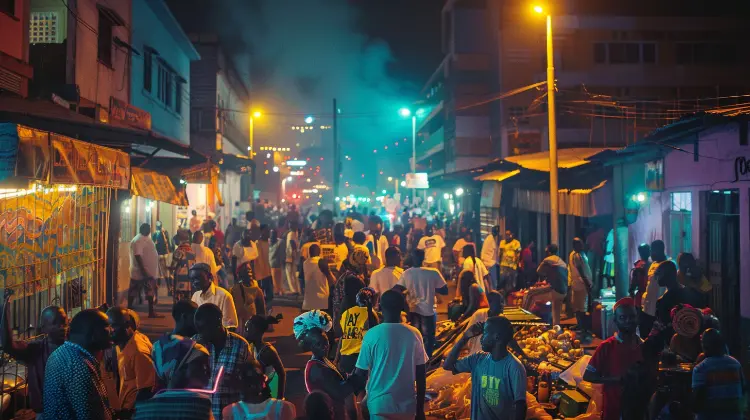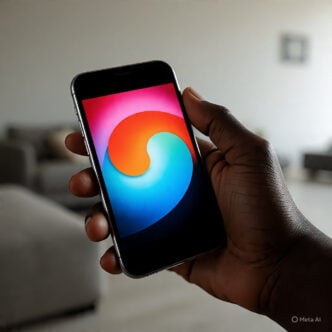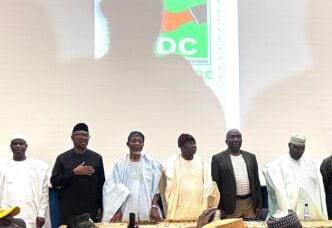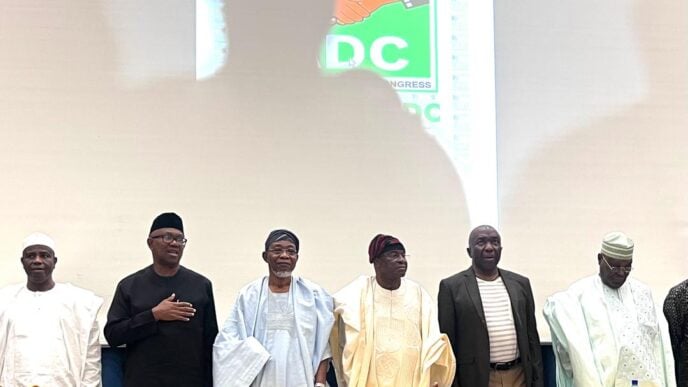A night market in Lagos
BY ARIWOOLA SAMUEL AKINWALE
Lagos presents a chaotic rhythm similar to the symphony of jazz music. The high tempo observed at certain hours of the day is followed by a low amplitude that escapes the eye. In this reflection, I draw attention to this symphony, demonstrated in the lived experience of the people through this chaotic rhythm and their expressions, which reflect the paradox and irony of its uniqueness.
The chaotic atmosphere grounds creative expression in the art, music, language, subcultures, nuances, and lifestyle of Lagosians. The dialectic of chaos and creativity in Lagos is mirrored in the residents’ delicacies, food, music, technology, arts, crafts, sports, and trade. Lagosians’ survival instinct manifests as sharpness, speed, and street intelligence.
Ewa Agoyin (mashed beans and peppery sauce) and Agege bread (a soft, stretchy loaf) are examples of ingenuity borne of the constraints and improvisation of working-class migrants, traders, and street workers. Today, Afrobeats and Fuji stars are claimants to the creative chaos of Lagos, drawing from street nuances, slogans, and jargon in their lyrics.
Advertisement
Fela’s lyric “99 standing, no seat” could only have come from a place like Lagos. This song mirrors the chaotic, overpopulated transport system—particularly the molue buses of the 1970s–80s. Davido, Asake, Wizkid, and many Afrobeat stars owe much to this city in their songs. The popular Lagos slogan turned anthem, “Eko o ni baje o,” is a core part of this identity. Burna Boy’s lyric, “Dangote still dey find money o,” reflects Lagos’s pervasive hustle culture. Asake’s “no dey form boss for my head” is an expression of the Lagos-street assertion of independence and pride. “I no get time for no money” is Burna Boy drawing from a Lagos-street slogan, an expression of focus and survival in an environment of constant distractions and slowdowns.
This rhythm is evident in the heart of the city. Egbeda comes to mind with its peculiar mix of chaos and creative existence. Egbeda offers a window into Lagos’ broader rhythm—a symphony where survival, commerce, and culture intersect.
In the heart of Lagos, Egbeda sprawls across the landscape—stretching to the north where it meets Iyana Ipaja and Agege, bordered to the south by Igando and Isolo, and to the east and west by Idimu and Ikeja respectively. A winding road traverses the community, stretching to Iyana Ipaja and Toll Gate in the north, while to the south, it links to major hubs like Ikeja and Oshodi. Keke Marwa, korope, utility vans, and BRT buses share Egbeda’s roads with motorcycles and pedestrians throughout the day.
Advertisement
A potpourri of Lagos cosmopolitanism, upon scrutiny, Egbeda wavers between urbanity and rural entreaties due to its demographic composition. Here, Nigeria is fully grounded—a place where any Nigerian ethnic group can be found. It encapsulates real urban sophistication and raw urban expressions in the character and lived experience of its residents.
It claims some of the biggest bars and clubs on the mainland. Egbeda sleeps late and rises late compared to its neighbours. It combines an admixture of a peculiar shyness with the refined character of Lagos. All kinds of work and engagements occupy the people’s time—from mundane to sophisticated callings. The traffic is less busy by Lagos standards, with chaotic road networks that run through the corridors and inner chambers of this urban sprawl. The finesse and style aren’t spectacular but are quite original in their modest appearance.
Here, anything sells—from water to sand—nothing is free. It is a transactional community where living and survival are negotiated with both the characteristic risk and confidence that Lagos requires.
The lived experience inside a korope, the small buses used for urban transportation, is an interesting spectacle. The driver is likely a haggard-looking man with missing canines who is ably assisted by an equal character in look and rough accoutrement called the ‘conductor’. Together they are like Siamese twins; you would almost take them for siblings—not of blood, but of alcohol, cigarettes, and drugs. Negotiating fares with these transporters requires both confrontation and wit. Success in this haggling, which can seem coercive and ungentlemanly to the uninitiated, is a victory in itself. The cost of a journey is dictated by the weather, the time of day, and the desperation of passengers. When the weather is very hot or rainy, or when it coincides with the closing hour for office workers, the cost of transportation soars.
Advertisement
In the same bus, you could have a preacher who brings his religious faith to the public, hoping to win a convert. This is not to mention the roadside preachers with blaring mics and loudspeakers, filling the air with their messages during the early morning rush hour.
The atmosphere presents a chaotic landscape with a salient symphony understood by residents in their negotiation of space, traffic meanderings, and class identity. Yet, it offers an interesting landscape for exploration. The distinct experience of the place—its liveliness, canvas, and atmosphere—is a case study for living in the urban sprawl of Lagos.
By its nature, crime is less visible or reported. But underlying the reticent look is an indulgent and lurking criminal enterprise that may not be evident to the uninitiated. Drugs and prostitution, two vices of grave amplitude in Lagos, are rarely seen openly in Egbeda. But for what it lacks in this, it makes up for with bars and sepe joints, where spirits and gins in sachets are served in small cups in cramped sheds.
The power of this lived space is in the contour of its distinct geography—a densely populated community housing the aspirational middle and working classes together. This is what a typical Lagos locale looks like.
Advertisement
As a creative hub, music genres have emerged from here. Highlife was imported from Ghana but was adapted locally in Lagos from the 1940s to the 1970s. Yoruba street entertainment and palm-wine music, refined in Lagos dance halls and bands, shaped Juju music in the 1950s–1980s through icons like Ebenezer Obey, King Sunny Ade, and Tunde Nightingale. Fela Kuti fused jazz, funk, and Yoruba rhythm. Fuji evolved from were music in Lagos ghettos through the likes of Sikiru Ayinde Barrister and Kollington Ayinla. Naija Hip-Hop and Afrobeats all emerged from the creativity of its artists.
The banter and theatrics of two drivers who have blocked the road, with passengers stuck inside their buses while they engage in empty threats and fisticuffs amidst the afternoon heat and the blaring of horns, is fuel for any creative artist. In literature, Teju Cole’s Every Day is for the Thief and Elnathan John’s Becoming Nigerian are drawn from such spectacles. In photography, the work of George Osodi, Andrew Esiebo, and the Lagos Photo Festival reflects the city’s social life. The sites of mechanics in Mushin, phone technicians in Computer Village, welders in Mile 2, panel beaters in Ojuelegba, carvers in Epe, and furniture and metal fabricators in Orile and Alaba are the living laboratories of innovation in Lagos.
Advertisement
This is Lagos— a reminder of the complexity of living, street smartness and intelligence expected of all who inhabit this space. This is the story of Lagos, “Eko o ni baje”.
Ariwoola Samuel Akinwale wrote this piece from Lagos. He can be contacted via [email protected]
Advertisement
Views expressed by contributors are strictly personal and not of TheCable.






